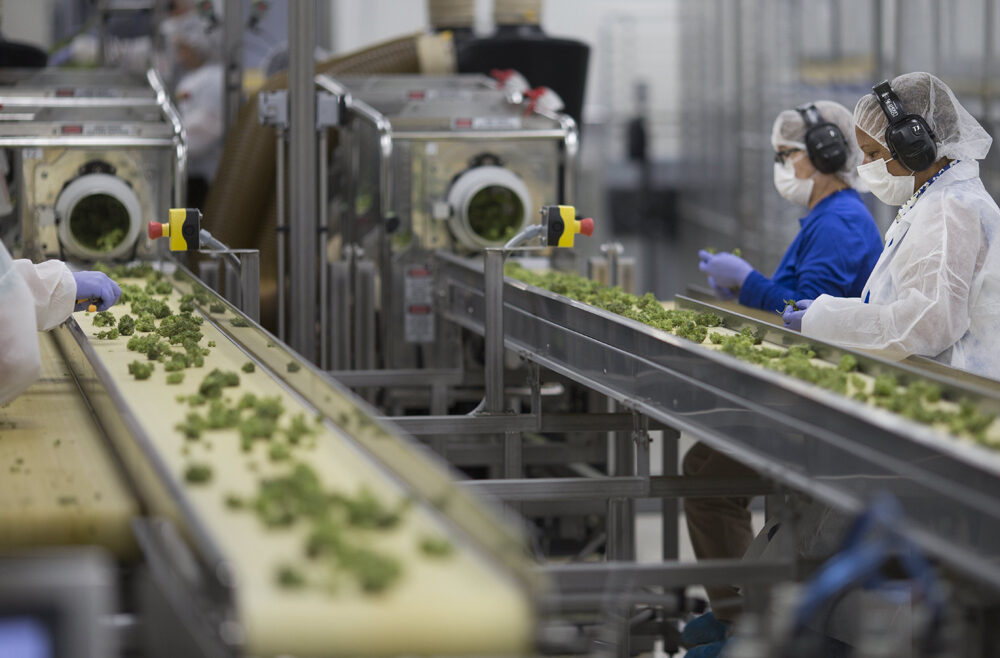The drastic mechanization of agriculture is no new phenomenon in the United States. How we grow and harvest our crops has been greatly influenced by the development of new technologies. Shaped by inventions like the gasoline powered tractor introduced at the end of the 20th century and the mechanical potato harvesting machine in 1951 which could dig, sort, and pack, all without a single touch of human hands. Our tractors now have GPS driven autopilot systems enabling them to create mathematically perfect rows, drones that can identify plant diseases from fly over photographs, and AI enabled berry picking machines that can identify bruising on a fruit.
Mechanization is now our norm.
But how has this impacted cannabis? As a crop, cannabis has largely been left out of mainstream innovations and markets as it was historically forced into the shadows through decades of prohibition. Growing the plant, harvesting, and processing were all largely done in secrecy, hidden in the cover of thick forests and tucked away in old barns.
With the emergence of legal cannabis, the new market has steadily become one of the fastest growing agricultural markets in California and throughout North America. Projections on the value of the North American Cannabis Market for 2021 is estimated to be over $20 billion US dollars. With this newly opened market and rapid economic burst robotics companies from across the world have been vying for the spotlight in mechanized cannabis harvesting and trimming. Any why not? The use of machines to meet the demand for this new commodified market quickly and efficiently would catch the eye of any savvy businessperson.
Early designs of trim machines have advanced rapidly to encompass the needs of large cannabis producers, like the Twister T2 which can process up to 19 pounds of cannabis within one hour. For farms producing massive quantities of product this must be quite enticing. However, as many cultivators have found, the hype really is too good to be true.
Despite advances in design, trim machines still have a well–earned reputation for damaging the delicate buds. The cost of that hyper-efficient production is quality. Industrial farms pumping out thousands of pounds of cannabis need to quickly package buds in order to get them to retailers as fast as possible, sacrificing the care and scrutiny given to each bud by human attention. For boutique and small legacy farmers every single bud and every piece of the plant is precious. When a farm produces a few hundred pounds a year, the quality of that harvest is tantamount.
One thing that mechanization can never replicate is the human ability to adjust to variety and diversity. Craft cannabis grown for its particular attributes; smell, flavour, colour, and experience, may not be the standardized dense football shaped buds the trim machines are designed to rapidly chew through. Despite the promise of sterile robotic efficiency, the machines have not been able to match the skillfulness of an experienced human hand. Trained trimmers can adjust the style and process of trimming to account for size, shape, structure, and variety in the flower. The standardized one size fits all trim machine cannot deliver the qualities needed to showcase the typicity of each individual cultivar.
In sticking to their roots, small farms that still process quality cannabis by hand are carrying on the rich history of dedication and direct connection to the plant. The importance of that connection is demonstrated easily by a quick glance at the finished product. Hand harvested and trimmed flowers are lovingly crafted into gorgeous trichome laden buds, with the natural shape for the individual cultivar and characteristics shining through. This difference is obvious, even from a first glance at a jar a consumer can quickly assess the quality of the cannabis.
In an increasingly competitive industry pushing to meet demand and drive profit, a hand trimmed nug is a demonstration of dedication, heritage, and a legacy of connection in defiance of the comprise of big agriculture. At Elevated Roots, we ‘Trim Against the Machine’ to preserve our connection with quality and the love of what we do. We still trim by hand, we still hand select the best cultivars, and cultivate with care and patience to create the best quality organic product we can. Inventiveness and an increase in automation will always drive better machines and more ways to incorporate robotics into farming, and into cannabis. But for now, we enjoy the sound of a calm breeze through the garden to that of an engine, and the sound of clicking trimming scissors to the rumble of a trim machine.

